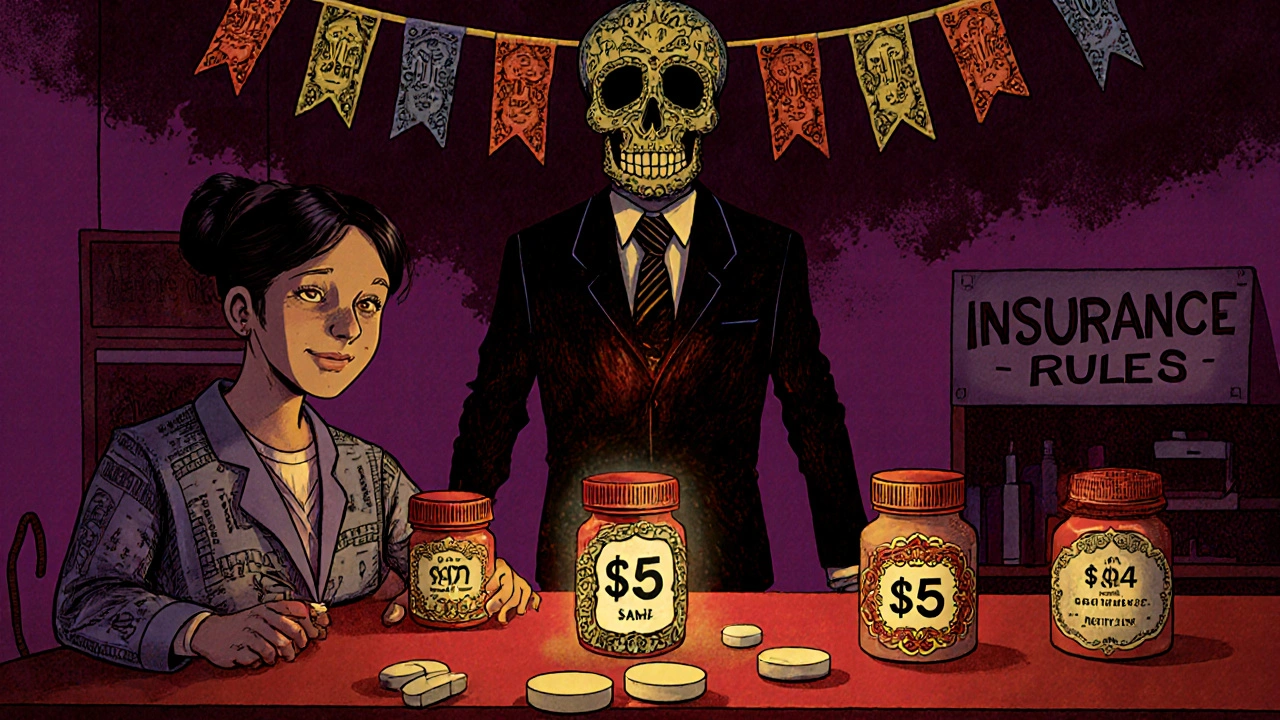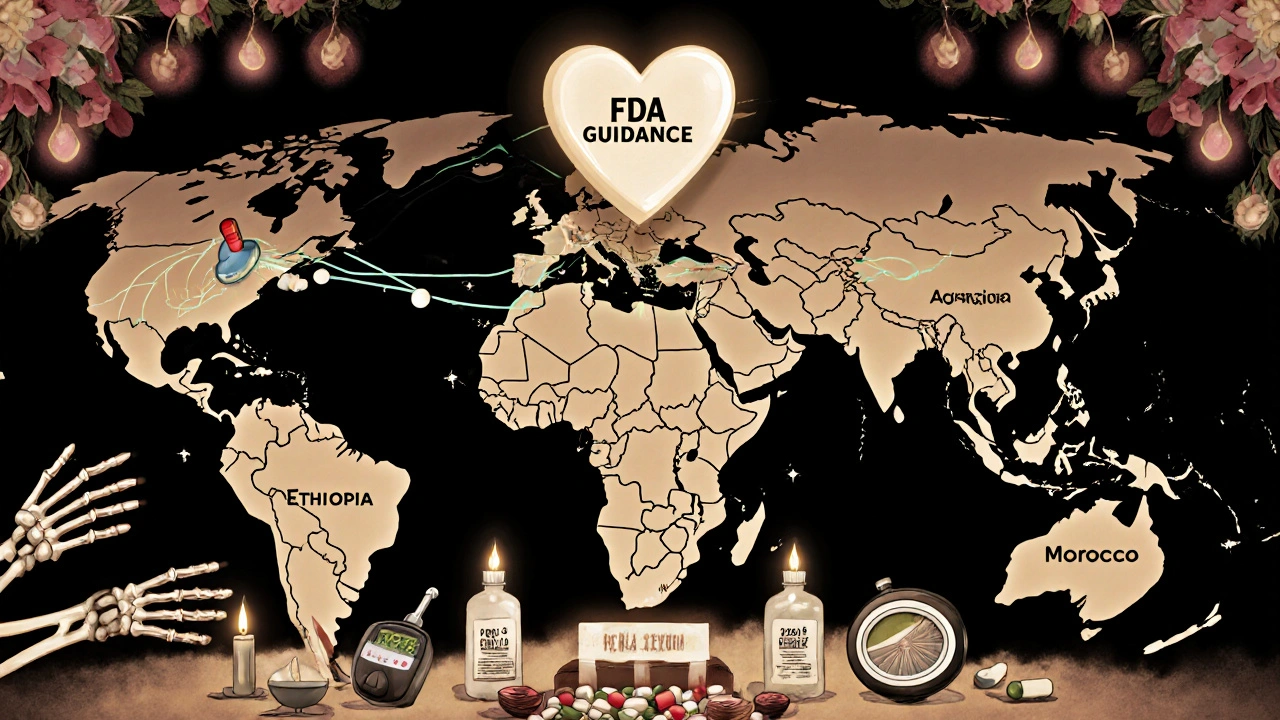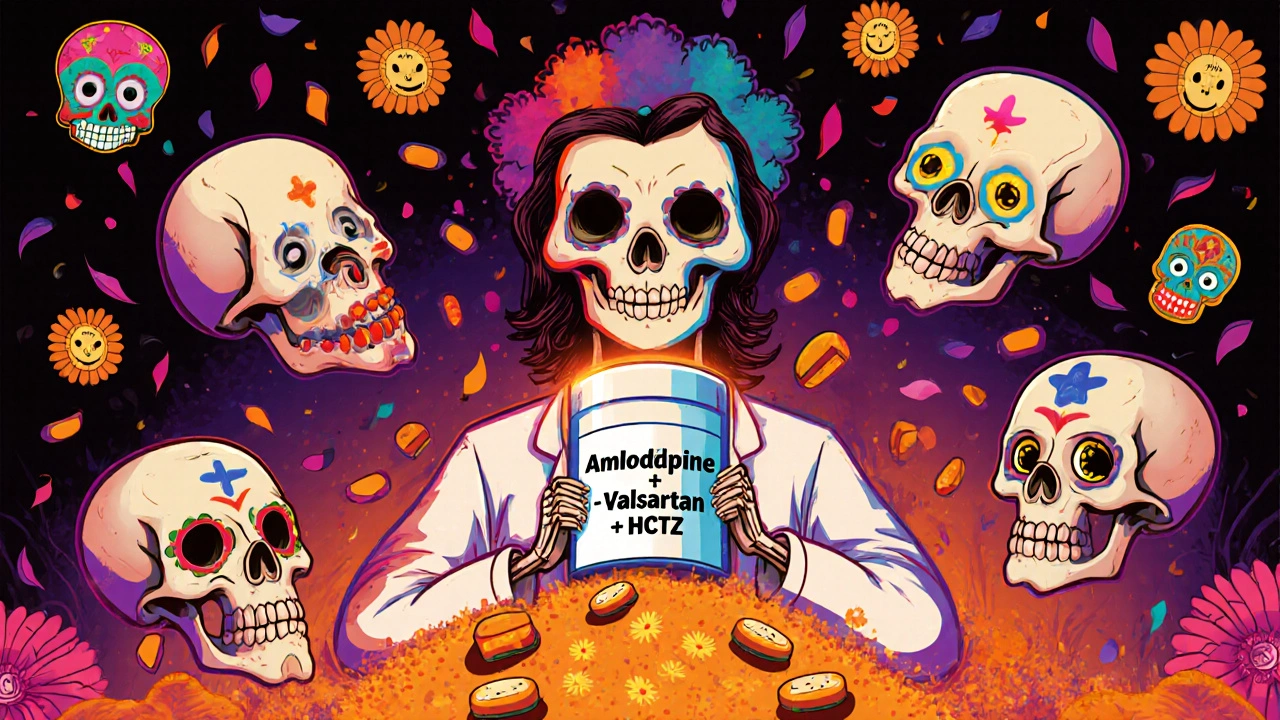Most people with high blood pressure need more than one pill to get their numbers under control. Studies show that 70-80% of hypertensive patients require two or more medications to reach target levels below 140/90 mmHg. That’s why doctors often prescribe antihypertensive combination generics - single pills that pack two or even three blood pressure drugs into one. They’re not new, but their availability, cost, and insurance coverage are still confusing for patients and providers alike.
What Are Antihypertensive Combination Generics?
These are called Single-Pill Combinations (SPCs) or Fixed-Dose Combinations (FDCs). Instead of taking three separate tablets - say, one for a calcium channel blocker, one for an ACE inhibitor, and one for a diuretic - you take one pill that contains all three. The most common combinations include:
- Amlodipine + Benazepril (Lotrel)
- Losartan + Hydrochlorothiazide (Hyzaar)
- Amlodipine + Valsartan (Exforge)
- Amlodipine + Valsartan + Hydrochlorothiazide (Triamterene/HCTZ combinations)
- Lisinopril + Hydrochlorothiazide (Zestoretic)
These aren’t brand-name drugs anymore. Over 85% of combination antihypertensive prescriptions in the U.S. in 2023 were generics, according to IQVIA. That means you’re getting the same active ingredients as the brand versions, but at a fraction of the cost - if your insurance lets you use them.
Why Do These Combinations Matter?
It’s not just about convenience. Taking multiple pills daily is hard. People forget. They get overwhelmed. A 2021 study found that patients on single-pill combinations were 15-25% more likely to stick with their treatment than those taking the same drugs separately. That’s huge. Better adherence means fewer heart attacks, strokes, and hospital stays.
Take a real example: A patient on amlodipine 5mg, valsartan 80mg, and hydrochlorothiazide 12.5mg separately might be paying $4.50 + $7.80 + $5.20 = $17.50 per month for generics. The same combo in one pill? Around $18.75. At first glance, the single pill costs more. But if you’re taking three pills, you’re more likely to miss one. And missing one pill can spike your blood pressure. The real savings? In hospital bills avoided.
What’s Actually Available in the U.S.?
The FDA has approved over 30 different combination antihypertensive generics. Here’s what you can realistically find at most U.S. pharmacies:
| Combination | Common Dosage | Generic Brand | Average Monthly Cost |
|---|---|---|---|
| Amlodipine + Benazepril | 5mg/20mg | Lotrel | $17.55 |
| Losartan + Hydrochlorothiazide | 50mg/12.5mg | Hyzaar | $10.60 |
| Lisinopril + Hydrochlorothiazide | 10mg/12.5mg | Zestoretic | $12.30 |
| Amlodipine + Valsartan | 5mg/160mg | Exforge | $18.75 |
| Amlodipine + Valsartan + Hydrochlorothiazide | 5mg/160mg/12.5mg | Tri-combo | $32.40 |
| Benazepril + Hydrochlorothiazide | 20mg/12.5mg | Lotensin HCT | $38.05 |
Prices vary by pharmacy and region. Walmart, Costco, and GoodRx partners often have the lowest rates. Some plans even offer these for $0-$5 with a coupon. But here’s the catch: not all combinations are available in every dose.
The Big Problem: Dosing Isn’t Flexible
One major downside of SPCs is rigidity. If your doctor wants to adjust one drug but not the other, you’re stuck. For example:
- Azor (amlodipine + olmesartan) comes in 5mg/20mg or 10mg/40mg. No 2.5mg/40mg option.
- If you need amlodipine 2.5mg with valsartan 160mg, that combo doesn’t exist as a pill.
You can’t split a pill and expect consistent dosing. Many combination pills aren’t scored. So if your ideal dose isn’t available in a single pill, you’ll have to go back to taking separate medications. This frustrates patients who thought the combo would solve everything.

Insurance Won’t Cover the Combo - But Covers the Individual Pills
This is where things get unfair. Many insurance plans cover the individual generic pills at $5 each - but charge $40+ for the same drugs in one pill. Why? Because the pharmacy benefit manager (PBM) makes more money when you buy three separate prescriptions. It’s a financial incentive to keep you on multiple pills.
Patients on Reddit and PatientsLikeMe report this constantly. One user wrote: “My insurance pays $5 for amlodipine, $5 for losartan, $5 for HCTZ. But the combo? $45. I have to take three pills just to save money.”
That’s not just illogical - it’s harmful. It discourages adherence. If you’re paying more for the easier option, you’ll likely go back to the harder one - and miss doses.
What About Outside the U.S.?
Availability drops sharply in low- and middle-income countries. A 2021 study found that while 20 of 26 LMICs had access to generic SPCs, 4 countries - Ethiopia, Morocco, Afghanistan, and Turkey - had no confirmed availability despite global manufacturing capacity. Even when available, cost and supply chain issues make them hard to get.
The WHO reports that in low-income countries, fewer than 50% of essential antihypertensive medicines, including combinations, are reliably available. That’s why 95% of people with high blood pressure in those regions can’t get their numbers under control - not because they don’t need the drugs, but because they can’t get them.
How to Get the Right Combination
Here’s how to navigate this mess:
- Ask your doctor if a combination pill is right for you. Don’t assume you need three pills.
- Check GoodRx or SingleCare for cash prices before insurance. Sometimes cash is cheaper.
- Call your pharmacy and ask: “Do you carry generic [combination name]?” Not all pharmacies stock every combo.
- Ask your insurer for a formulary list. Look for the specific generic combination name, not just the brand.
- If the combo is too expensive, ask if you can get the individual generics at a lower price. Sometimes, three $5 pills are better than one $40 pill.
Don’t be afraid to push back. If your doctor recommends a combo but your insurance won’t cover it, ask for a prior authorization. Mention the clinical evidence: better adherence, fewer complications, lower long-term costs.

What’s Changing in 2025?
The FDA issued new draft guidance in September 2023 to make it easier to approve new generic combinations. That means more options are coming - especially triple-combination pills. A 2022 study predicted that if triple-combos became widely available in low-income countries, they could cut the hypertension treatment gap by 35%.
But availability doesn’t equal access. Without changes in insurance policies, provider education, and global supply chains, these new pills won’t help the people who need them most.
Bottom Line: It’s Not Just About the Pill
Antihypertensive combination generics are a smart tool. They work. They save lives. But they’re not magic. Their value depends on:
- Whether the exact dose you need is available
- Whether your insurance treats them fairly
- Whether your doctor knows how to prescribe them
- Whether you can actually get them at the pharmacy
If you’re on multiple blood pressure pills, ask if a combination could simplify your routine. If your insurance won’t cover it, ask why - and push for a better option. You’re not just managing a number. You’re protecting your heart, your brain, and your future.
Are antihypertensive combination generics as effective as brand-name versions?
Yes. The FDA requires generic combination pills to prove they deliver the same amount of active ingredients into your bloodstream as the brand-name version, within a strict 80-125% range. Studies show they lower blood pressure just as effectively. The only difference is cost - generics are usually 80-90% cheaper.
Can I split a combination pill to adjust my dose?
No, and it’s not safe. Most combination pills aren’t scored, and splitting them can lead to uneven dosing. If you need a dose that’s not available in a combo pill - like amlodipine 2.5mg with valsartan 160mg - you’ll need to take the individual components separately. Talk to your doctor about alternatives.
Why does my insurance cover the individual pills but not the combo?
It’s a financial decision, not a medical one. Pharmacy benefit managers (PBMs) often make more money when you buy multiple separate prescriptions. Even if the pharmacy pays $10 for the combo and $12 for the three individual pills, the PBM may charge you more for the combo to discourage its use. This is a known loophole in the system.
What’s the cheapest antihypertensive combination generic?
Losartan/hydrochlorothiazide (Hyzaar generic) is often the cheapest, with cash prices as low as $10.60 per month at Walmart or Costco. Lisinopril/HCTZ is also very affordable, usually under $13. Always compare prices using GoodRx - it’s free and updated daily.
Do triple-combination generics exist?
Yes. Amlodipine/valsartan/hydrochlorothiazide is available as a generic and is growing in use. These are ideal for patients who need strong blood pressure control and have struggled with two-drug regimens. They’re not as widely stocked yet, so you may need to ask your pharmacy to order them.
Are combination generics safe for older adults?
Generally yes, but caution is needed. Some combinations, like those with ACE inhibitors or diuretics, require dose adjustments in patients over 75 or those with kidney or liver issues. Always start low and go slow. Your doctor should review your kidney function and electrolytes before prescribing.
Can I switch from individual pills to a combination pill on my own?
No. Never switch your blood pressure medications without your doctor’s approval. Even though the ingredients are the same, the timing, absorption, and dosing can differ slightly. Your doctor needs to monitor your blood pressure and kidney function during the transition.
What to Do Next
If you’re taking two or three blood pressure pills a day, ask your pharmacist or doctor: “Is there a single-pill version of what I’m taking?” If they say no, ask why. Check GoodRx for cash prices. If the combo costs less than your three separate pills, push for it. If insurance blocks it, ask for a prior authorization - and cite the American Heart Association’s guidelines, which recommend SPCs as first-line for most patients with stage 2 hypertension.
High blood pressure doesn’t care if your pill is one or three. It only cares if you take it. And the simpler the regimen, the better your chances of staying in control - for years to come.


Franck Emma
November 21, 2025 AT 09:14This insurance bullshit is literally killing people.
Noah Fitzsimmons
November 22, 2025 AT 11:14Oh wow, a whole article about combo pills and not a single mention of how PBMs are the real villains here? Groundbreaking. Next you’ll tell me oxygen is expensive when you’re not on Medicare.
Pravin Manani
November 22, 2025 AT 20:14From an Indian clinician’s perspective, the global disparity in access is staggering. In urban India, we see SPCs like amlodipine-valsartan at ₹15/month (~$0.18) through government schemes, but in rural clinics, even those are out of stock. The WHO’s 50% availability metric? That’s generous. We’ve got patients on three separate generics because the combo isn’t stocked, and the pharmacy doesn’t even have a backorder system. The real tragedy isn’t the dosing rigidity-it’s that the people who need these pills most are the ones who can’t even find the damn shelf.
And yes, the PBM model is predatory, but in LMICs, it’s not even about PBMs-it’s about cold chains, corruption, and import tariffs that make a 12.5mg HCTZ tablet cost more than a week’s rice ration. We need tiered global pricing, not just GoodRx coupons.
Also, triple combos? We’ve been using them for years in our hypertension clinics. Amlodipine-valsartan-HCTZ is now first-line for stage 2. But only if the patient can walk to a pharmacy that’s open past 6 PM. Otherwise? It’s back to the three-pill routine, with the wife reminding them twice a day.
Simone Wood
November 23, 2025 AT 08:10Let me just say this: if your insurance covers three $5 pills but not the $40 combo, they’re not saving you money-they’re gambling with your kidneys, your brain, and your lifespan. This isn’t healthcare policy. It’s financial engineering disguised as cost control. And the fact that the FDA is finally pushing for more combos? Only because the public outcry got too loud. They’ve known this was broken for a decade.
And don’t get me started on the ‘you can’t split pills’ argument. My neighbor tried splitting a scored amlodipine-losartan pill because the pharmacy ran out of 5/100mg and only had 10/200mg. She ended up in the ER with hypotension. The pill didn’t split evenly. The active ingredients aren’t uniformly distributed. It’s not a candy bar.
Someone needs to sue these PBMs. Not just complain on Reddit.
Paula Jane Butterfield
November 24, 2025 AT 18:45As a nurse who’s been managing hypertension for 18 years, I’ve seen patients cry because they can’t afford their meds-and then get mad at themselves for forgetting to take them. The combo pill isn’t a luxury. It’s dignity. I’ve had patients who take 12 pills a day for everything-diabetes, thyroid, cholesterol, pain-and when I switch them to a combo, they say, ‘I can finally sleep at night.’
And yes, I’ve had insurance deny combos and approve three separate pills… even when the combo cost less. I write letters. I call the PBM. I’ve had them reverse denials after citing AHA guidelines. It’s exhausting. But if you’re reading this and you’re on multiple pills? Ask your pharmacist to check GoodRx. Sometimes cash is cheaper than insurance. And if your doctor says no to a combo? Ask why. Push. You’re not being difficult-you’re being smart.
Also, if you’re over 70? Please, please, please get your potassium and creatinine checked before starting any combo with an ACE/ARB and diuretic. I’ve seen too many people crash their kidneys because someone assumed ‘generic = safe for everyone.’
Swati Jain
November 25, 2025 AT 07:54Oh so now we’re all supposed to be grateful because amlodipine-valsartan-HCTZ exists? Sweet. Now tell me why I can’t get the 2.5/80/6.25 dose in India? Or why my cousin in Delhi has to drive 40km to a private clinic just to get a combo that’s been FDA-approved since 2020? This isn’t innovation. It’s privilege.
And don’t even get me started on the ‘ask your doctor’ advice. My doctor in Mumbai doesn’t even know what Exforge generic is called here. He just prescribes the brand because the rep gave him free pens. The system is rigged from the top down.
But hey, at least we have GoodRx. If you’re in the US, you’re basically playing a game where the rules change every time you reload the page. I’m just glad I’m not trying to get this in Nigeria.
Florian Moser
November 27, 2025 AT 00:09One of the most overlooked benefits of SPCs is the reduction in pill burden for elderly patients with polypharmacy. A 2022 JAMA study showed a 31% reduction in medication errors among patients over 70 switched from separate pills to fixed-dose combinations. This isn’t just about convenience-it’s about safety. And the data on adherence is rock solid: patients on SPCs are 22% more likely to remain on therapy at 12 months. That’s not a small number. That’s a life saved.
If your insurance denies coverage, request a prior authorization citing the 2023 AHA/ACC guidelines, which explicitly recommend SPCs as first-line for stage 2 hypertension. Include the cost comparison: three $5 pills = $15/month, but if you miss one dose, your risk of stroke increases by 37%. That’s not a cost-it’s a liability.
And yes, dosing inflexibility is a real issue. But that’s why we need more formulations, not fewer. Advocacy works. The FDA’s 2023 draft guidance is a direct result of patient and provider pressure. Keep pushing.
Shawn Sakura
November 28, 2025 AT 19:30hey i just wanted to say this article made me cry a little 😭 i know this sounds crazy but i’ve been on three blood pressure pills for 5 years and i forgot one last week and my head felt like it was gonna explode. i switched to the combo last month and i swear i sleep better. my wife says i don’t yell at the tv as much anymore. i’m not a doctor but i think this stuff matters. thank you for writing this. p.s. i spelled ‘combination’ wrong in my notes like 37 times but i got the pill now so it’s fine lol
jim cerqua
November 29, 2025 AT 12:40Let’s be real: this whole system is a fucking circus. PBMs make money off your non-adherence. They literally profit when you miss a pill. They don’t care if you have a stroke-they care if you buy three prescriptions instead of one. And doctors? Half of them don’t even know the difference between a 5/160/12.5 combo and a 10/80/6.25. They just prescribe what’s in the formulary.
And don’t get me started on the ‘just use GoodRx’ advice. That’s like telling someone with a broken leg to just walk slower. The fact that we’ve turned a life-saving medical intervention into a coupon-based scavenger hunt is a national disgrace.
Meanwhile, in India, a woman takes a 10mg/160mg/12.5mg combo for $0.25 a day. Here, we’re fighting insurance bots for $18. This isn’t healthcare. It’s capitalism with a stethoscope.
And yes, triple combos are coming. But they’ll be priced at $90 until someone sues. And then they’ll be priced at $75 until the PBM changes the formulary again. It’s a game. And we’re all losing.